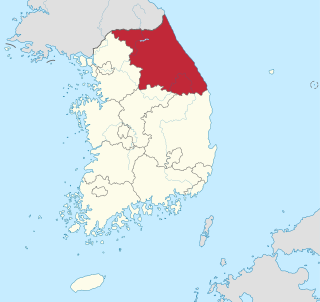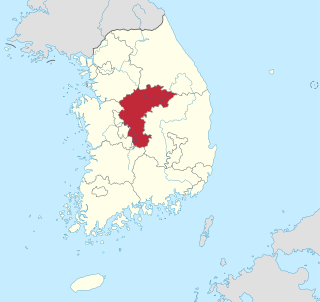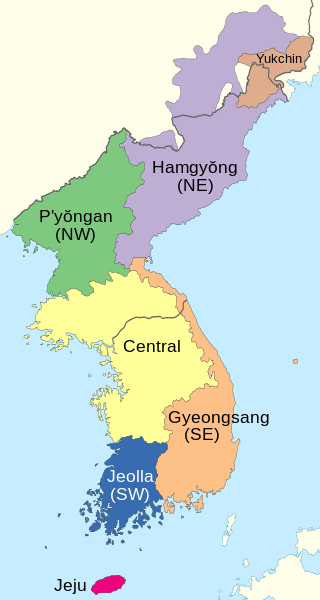Korea's provinces have been the primary administrative division of Korea since the mid Goryeo (Koryo) dynasty in the early 11th century, and were preceded by provincial-level divisions dating back to Unified Silla and Balhae during the Northern and Southern States period, in the 7th century.

Gangwon State is a Special Self-Governing Province of South Korea and the least densely populated subdivision of the country. Gangwon is one of the three provinces with special self-governing status, the others being Jeju Province and Jeonbuk State. On the east bound by the East Sea, it borders Gyeonggi Province to its west, North Gyeongsang Province and North Chungcheong Province to its south, and the Military Demarcation Line to the north, separating it from North Korea's Kangwŏn Province. Before the division of Korea in 1945 Gangwon and Kangwŏn Provinces formed a single province.

Jeonbuk State, also known as Jeonbuk is a Special Self-governing Province of South Korea in the Honam region in the southwest of the Korean Peninsula. Jeonbuk borders the provinces of South Chungcheong to the north, North Gyeongsang and South Gyeongsang to the east and South Jeolla to the south.

South Chungcheong Province, also known as Chungnam, is a province of South Korea in the Hoseo region in the southwest of the Korean Peninsula. South Chungcheong borders the provinces of Gyeonggi to the north, North Chungcheong, Sejong Special Self-governing City, and Daejeon Metropolitan City to the east, and North Jeolla to the south.

North Chungcheong Province, also known as Chungbuk, is a province of South Korea. North Chungcheong has a population of 1,578,934 (2014) and has a geographic area of 7,433 km2 (2,870 sq mi) located in the Hoseo region in the south-center of the Korean Peninsula. North Chungcheong borders the provinces of Gyeonggi and Gangwon to the north, North Gyeongsang to the east, North Jeolla to the south and South Chungcheong, Sejong Special Autonomous City and Daejeon Metropolitan City to the west.

Jeolla Province was one of the historical Eight Provinces of Korea during the Kingdom of Joseon in southwestern Korea. It consisted of the modern South Korean provinces of North Jeolla, South Jeolla and Gwangju Metropolitan City as well as Jeju Province. The provincial capital was Jeonju, the current capital of North Jeolla. The entire inland region was called Honam, which is still commonly used today.

Chungcheong was one of the eight provinces of Korea during the Joseon Dynasty. Chungcheong was located in the southwest of Korea. The provincial capital was located at Gongju, which had been the capital of the kingdom of Baekje from 475 to 538. The cities who were on former province will host the 2027 Summer World University Games.

During most of the Joseon dynasty, Korea was divided into eight provinces. The eight provinces' boundaries remained unchanged for about 480 years from 1413 to 1895, and formed a geographic paradigm that is still reflected today in the Korean Peninsula's administrative divisions, dialects, and regional distinctions. The names of all eight provinces are still preserved today, in one form or another. These eight historical provinces form both North and South Korea, and are not to be confused with the provinces that make up South Korea or North Korea.
South Korea is made up of 22 first-tier administrative divisions: 6 metropolitan cities, 1 special city, 1 special self-governing city, and 14 provinces, including three special self-governing provinces and five claimed by the ROK government. These are further subdivided into a variety of smaller entities, including cities, counties, districts, towns, townships, neighborhoods and villages.

A number of Korean dialects are spoken on the Korean Peninsula. The peninsula is very mountainous and each dialect's "territory" corresponds closely to the natural boundaries between different geographical regions of Korea. Most of the dialects are named for one of the traditional Eight Provinces of Korea. Two are sufficiently distinct from the others to be considered separate languages, the Jeju and the Yukjin languages.
The Flagship National Universities is a collective term referring to ten universities in South Korea that have joined the "Presidential Council of the Korean Flagship National Universities".

The Chungcheong dialects of the Korean language are spoken in the Chungcheong (Hoseo) region of South Korea, including the metropolitan city of Daejeon. It may also include several areas in Gyeonggi Province, most notably Pyeongtaek, that are adjacent to Chungcheong Province. Chungcheong dialect can be divided into two categories: the Northern Chungcheong dialect, notable for its similarity capital Gyeonggi region speech, and the Southern dialect, which is similar to the Jeolla dialect. This dialect is notable for its slow enunciations, vowel changes, and unique jargon. However, as Seoul expands and standard language supremacy spreads, young people in Chungcheong Province, including Daejeon and Sejong, do not use original dialect, or use very little of it. Most young people use standard language and dialect alternately, and in cities located just below the Seoul metropolitan area (Sudogwon), like Cheonan, dialect is on the verge of extinction.
Korea Polytechnics (Korean: 한국폴리텍대학) mean two or three-years public vocational school in South Korea. It has 11 colleges in 34 cities.
In South Korea, highways that are managed by the provincial governments are called Local highways. Usually route numbers have 2~4 digits; the first digit stands for the main province of its manager.

Kōgen-dō, alternatively Kōgen Province, was a province of Korea under Japanese rule. Its capital was Shunsen (Chuncheon). The province corresponds to the combination of the modern Kangwon Province, North Korea and Gangwon Province, South Korea.

The high school standardization policy was introduced in South Korea in order to reduce the gap between high schools in the region since 1974, and instead of selecting students from high schools in the region, the entire student population is divided into general schools in each district.










